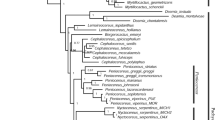Abstract
The phylogenetic relationships of Peniocereus (Cactaceae) species were studied using parsimony analyses of DNA sequence data. The plastid rpl16 and trnL-F regions were sequenced for 98 taxa including 17 species of Peniocereus, representatives from all genera of tribe Pachycereeae, four genera of tribe Hylocereeae, as well as from three additional outgroup genera of tribes Calymmantheae, Notocacteae, and Trichocereeae. Phylogenetic analyses support neither the monophyly of Peniocereus as currently circumscribed, nor the monophyly of tribe Pachycereeae since species of Peniocereus subgenus Pseudoacanthocereus are embedded within tribe Hylocereeae. Furthermore, these results show that the eight species of Peniocereus subgenus Peniocereus (Peniocereus sensu stricto) form a well-supported clade within subtribe Pachycereinae; P. serpentinus is also a member of this subtribe, but is sister to Bergerocactus. Moreover, Nyctocereus should be resurrected as a monotypic genus. Species of Peniocereus subgenus Pseudoacanthocereus are positioned among species of Acanthocereus within tribe Hylocereeae, indicating that they may be better classified within that genus. A number of morphological and anatomical characters, especially related to the presence or absence of dimorphic branches, are discussed to support these relationships.




Similar content being viewed by others
References
Anderson EF (2001) The cactus family. Timber Press, Portland
Arias S, Terrazas T, Cameron K (2003) Phylogenetic analysis of Pachycereus (Cactaceae, Pachycereeae) based on chloroplast and nuclear DNA sequences. Syst Bot 28:547–557
Asmussen CB (1999) Toward a chloroplast DNA phylogeny of the Geonomeae (Palmae). In: Henderson A, Borchsenis F (eds) Evolution, variation, and classification of palms. Mem NY Bot Gard 83:121–129
Barthlott W, Hunt DR (1993) Cactaceae. In: Kubitzki K (ed) The families and genera of vascular plants. Springer, Berlin Heidelberg New York, pp 161–197
Berger A (1905) A systematic revision of the genus Cereus. Annu Rep MO Bot Gard 16:57–86
Bravo-Hollis H (1978) Las cactáceas de México, vol. I. Universidad Nacional Autónoma de México, México D.F
Britton NL, Rose JN (1909) The genus Cereus and its allies in North America. Contr US Nat Herb 12:413–437
Britton NL, Rose JN (1920) The Cactaceae, vol 2. Carnegie Institution, Washington
Buxbaum F (1958) The phylogenetic division of the subfamily Cereoideae, Cactaceae. Madroño 14:177–206
Buxbaum F (1975) Gattung Peniocereus. In: Krainz H (ed) Die Kakteen. Franckh’sche Verlagshandlung, Stuttgart,
Cornejo DO, Simpson BB (1997) Analysis of form and function in North America columnar cacti (tribe Pachycereeae). Am J Bot 84:1482–1501
Distefano C (1956) Su un nuovo genere di Cactaceae: Cullmannia. Nuovo Giorn Bot Ital 63:158–161
Farris JS, Källersjö M, Kluge AG, Bult C (1995) Testing significance of incongruence. Cladistics 10:315–319
Gibson A, Nobel PS (1986) The cactus primer. Harvard University Press, Cambridge
Hunt H (1997) Further amendments to the CITES Cactaceae checklist. Cact Cons Init 3:12–15
Hunt D, Taylor N (1990) The genera of Cactaceae: progress towards consensus. Bradleya 8:85–107
Hunt D, Taylor N (1991) Notes on miscellaneus genera of Cactaceae. Bradleya 9:81–92
Maddison WP, Maddison DR (2000) McClade vers. 4.0. Sinauer, Sunderland
Marshall WT (1941) Cactaceae. Abbey Garden, Pasadena
Nyffeler R (2002) Phylogenetic relationship in the cactus family (Cactaceae) based on evidence from trnK/matK and trnL- trnF sequences. Am J Bot 89:312–326
Sánchez-Mejorada H (1973) El género Neoevansia Marshall historia y revisión. Cact Suc Mex 18:13–26
Sánchez-Mejorada H (1974a) El género Peniocereus, enmienda y división. Cact Suc Mex 19:36–41
Sánchez-Mejorada H (1974b) Revisión del género Peniocereus (Las cactáceas). Dirección de Agricultura y Ganadería, Toluca
Simmons MP, Ochoterena H (2000) Gaps as characters in sequence-based phylogenetic analysis. Syst Biol 49:369–381
Swofford DL (2002) PAUP*. Phylogenetic analysis using parsimony (*and other methods), version 4.0b10. Sinauer Associates, Sunderland
Taberlet P, Gielly L, Pautou G, Bouvet J (1991) Universal primers for amplification of three non-coding regions of chloroplast DNA. Plant Mol Biol 17:1105–1109
Taylor NP (1985) The genus Echninocereus. Kew Magazine Monograph, Kew
Terrazas T, Arias S (2002) Comparative stem anatomy in the subfamily Cactoideae. Bot Rev 68:444–473
Terrazas T, Loza-Cornejo (2002) Phylogenetic relationships of Pachycereeae: a cladistic analysis based on anatomical-morphological data. In: Fleming TH, Valiente-Banuet A (eds) Columnar cacti and their mutualists, evolution, ecology, and conservation. Arizona University Press, Tucson, pp 66–86
Thompson JD, Gibson TJ, Plewniak F, Jeanmougin F, Higgins DG (1997) The ClustalX windows interface: flexible strategies for multiple sequence alignment aided by quality analysis tools. Nucleic Acids Res 24:4876–4882
Wallace R (2002) The phylogeny and systematics of columnar cacti: an overview. In: Fleming TH, Valiente-Banuet A (eds) Columnar cacti and their mutualists, evolution, ecology, and conservation. Arizona University Press, Tucson, pp 42–65
Young ND, Healy J (2003) GapCoder automates the use of indel characters in phylogenetic analysis. BMC Bioinformatics 4:6
Acknowledgements
This research was completed in part with grant funding from UNAM (PASPA 154/2003) that allowed S. Arias to serve as a Visiting Scientist at The New York Botanical Garden. Further financial support was generously made possible by Consejo Nacional de Ciencia y Tecnología (33064-V) and the Lewis B. and Dorothy Cullman Foundation. We thank the Desert Botanical Garden, Huntington Botanical Garden, New York Botanical Garden, and U. Guzmán and A. Areces-Mallea who provided samples from their living collections for this work, as well as Ivonne Sanchez del Pino and Damon Little for technical support.
Author information
Authors and Affiliations
Corresponding author
Rights and permissions
About this article
Cite this article
Arias, S., Terrazas, T., Arreola-Nava, H.J. et al. Phylogenetic relationships in Peniocereus (Cactaceae) inferred from plastid DNA sequence data. J Plant Res 118, 317–328 (2005). https://doi.org/10.1007/s10265-005-0225-3
Received:
Accepted:
Published:
Issue Date:
DOI: https://doi.org/10.1007/s10265-005-0225-3




